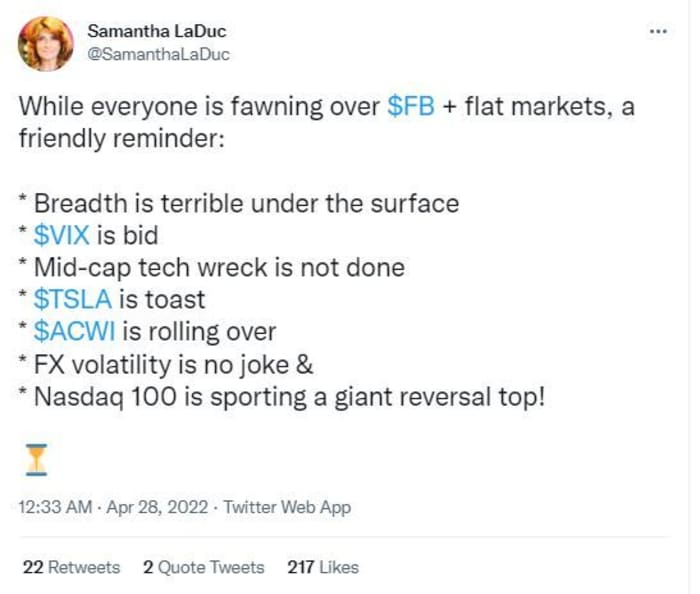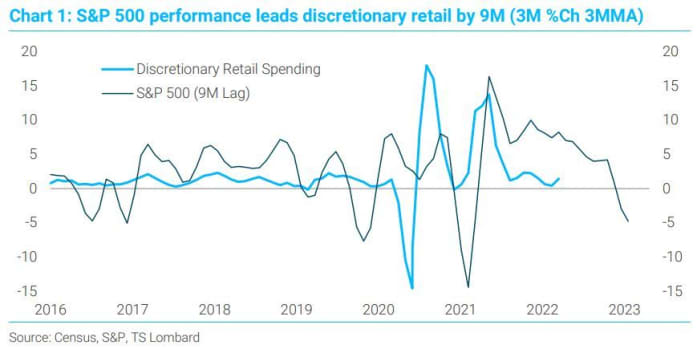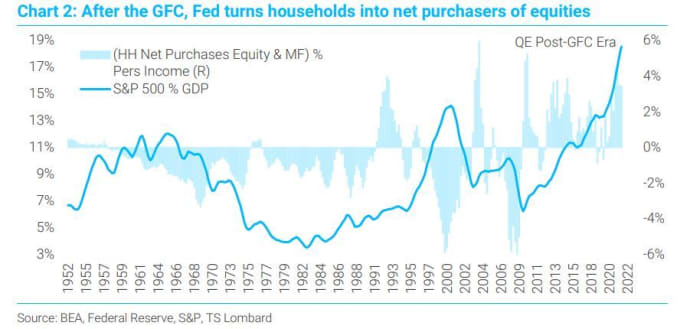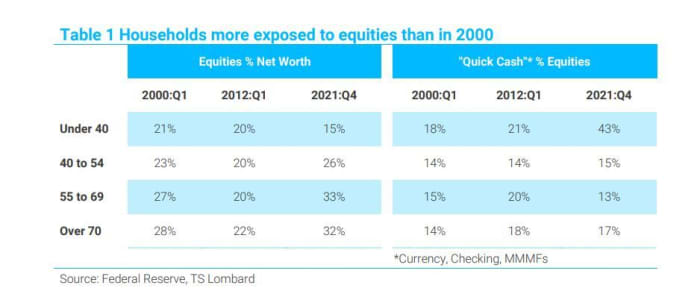This post was originally published on this site
A powerful, tech-led stock surge may be on the cards for Thursday, with Facebook parent Meta Platforms in the driver’s seat after less disastrous than feared results.
With earnings, inflation, a COVID-19 resurgence and war all in the balance, any equity gains could easily disappear in another sell-the-rip move. Wariness abounds as gross domestic product data loom, along with Amazon and Apple results due later.

On to our call of the day from TS Lombard’s chief U.S. economist, Steven Blitz, who sees the “golden era of Fed-controlled equity markets” coming to an end. (h/t The Market Ear).
As Blitz explained, if equity market weakness continues, with the S&P 500
SPX,
down 12% year to date, consumers may slash spending by the end of this year, if not sooner.
“The Fed’s communicated policy trajectory was intended to weaken equities — equities and the dollar are the Fed’s main conduits to impact the economy and, in turn, inflation,” said the economist, in a recent note. “An acceleration of current market weakness adds to our expected near-term downswing in spending and, more critically, threatens to embed a much weaker outlook for spending heading into next year.”

As for the connect between consumer spending and stock market performance, Blitz noted ties have tightened up since the global financial crisis of 2007-08, when households reacted by “long-tail deleveraging of their balance sheets.” He talked about how that sparked the Fed’s creation of an asset cycle centered on stocks, and households charged into equities because TINA [There is No Alternative] and the market only goes up, right?

His below chart shows how equities now, mostly, comprise a bigger chunk of household worth vs. early 2000. And as households sold into a late-90s rally instead of buying into the one that started in 2009, they are stuck with a higher cost-basis compared with the 2000 market crash. In short, they are more vulnerable to equity pullbacks.

The above chart notes, importantly, that young boomers (55 to 59) are most exposed to stocks — 46%, with the under 40 group least exposed at 3%. Generation X (40 to 54) owns 20%.
Why that matters?
“The combined 40-to-69 group accounted for 62% of consumer durables purchased since the economy bottomed in spring 2020. From here, it is easy to surmise that between satiated pent-up demand and falling equity valuations, consumer durable spending takes a hit,” he said.
Also consider that jump in cash relative to net worth as individuals age, said Blitz. The ratio is 15.4% for those 70 and over versus 11% for that young boomer crowd. “In other words, the 55 to 69 group likely begins to rebalance to cash, passively or actively. Regardless, equity market domestic demand shifts lower.”
The big question is how far will the Fed be willing to go to undermine confidence in its put — that is, market and investor belief that the central bank will step in to halt a slide in stocks.
“The Fed could very well end up undermining their future ability to drive household balances back into equities for the next upturn. The Fed’s ability will already be compromised to a point, anyway, by aging baby boomers rebalancing toward cash — a rebalancing aided by higher inflation and policy rates returning a yield to cash,” Blitz said.
Read: Here’s how far the S&P 500 has to fall to enter another stock-market correction
The buzz
Caterpillar
CAT,
stock is surging on results, while Merck
MRK,
also lifted on its earnings. Eli Lilly
LLY,
is rallying on a beat, along with McDonald’s
MCD,
and Twitter
TWTR,
are still to come. Qualcomm
QCOM,
is also up on upbeat results. Apart from Apple
AAPL,
(preview) and Amazon
AMZN,
(preview), Gilead
GILD,
and VeriSign will report after the close.
Stock in Facebook parent Meta Platforms
FB,
is surging on an earnings beat, even as sales were the slowest in a decade. Teladoc stock
TDOC,
is down 41% after a weak earnings outlook and a huge impairment charge.
Opinion: Facebook earnings weren’t as bad as feared, but they were still pretty bad
Data ahead of the open are expected to show first-quarter U.S. gross domestic product tumbling to 1% from 6.9% in the fourth quarter. Weekly jobless claims are also ahead, and for Friday we’ll get the Fed’s favorite inflation gauge.
Russian attacks in eastern Ukraine have picked up, as the European Union tries to keep members from caving to Moscow’s demands for gas payments in rubles, after Poland and Bulgaria were cut off. International Planned Parenthood, meanwhile, has sent thousands of morning-after pills into Ukraine, as reports of rapes by Russian soldiers rise.
The markets
Stock futures
YM00,
ES00,
are soaring, led by those for the Nasdaq-100
NQ00,
as bond yields
TMUBMUSD10Y,
TMUBMUSD02Y,
creep up, while oil is slipping. The euro
EURUSD,
is under pressure against a strong dollar, with the Japanese yen
USDJPY,
crushed to a two-decade low on a dovish Bank of Japan stance and unlimited bond buying vow.
The tickers
These were the most-searched tickers on MarketWatch as of 6 a.m. Eastern Time.
| Ticker | Security name |
|
TSLA, |
Tesla |
|
GME, |
GameStop |
|
TWTR, |
|
|
AMC, |
AMC Entertainment |
|
NIO, |
NIO |
|
AAPL, |
Apple |
|
ATER, |
Aterian |
|
CENN, |
Cenntro Electric |
|
NFLX, |
Netflix |
|
NVDA, |
NVIDIA |
Random reads
4,500-year-old goddess of beauty statue, complete with snake crown, found in Gaza strip.
The earth’s least-developed country grew 200 million trees.
Need to Know starts early and is updated until the opening bell, but sign up here to get it delivered once to your email box. The emailed version will be sent out at about 7:30 a.m. Eastern.
Want more for the day ahead? Sign up for The Barron’s Daily, a morning briefing for investors, including exclusive commentary from Barron’s and MarketWatch writers.

